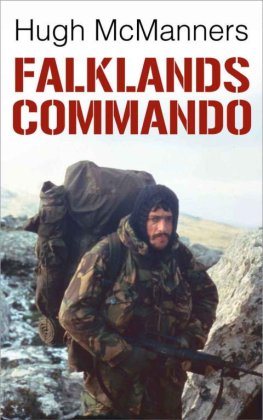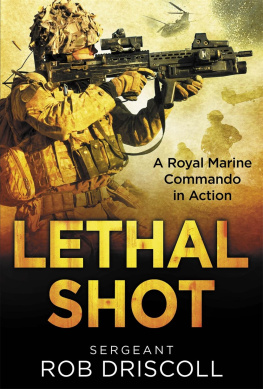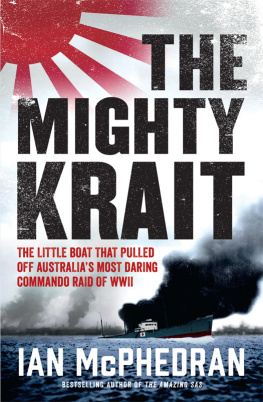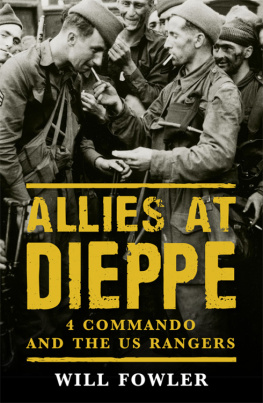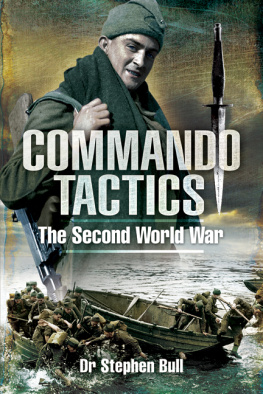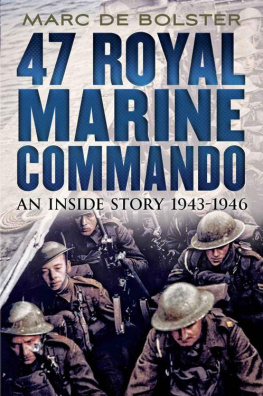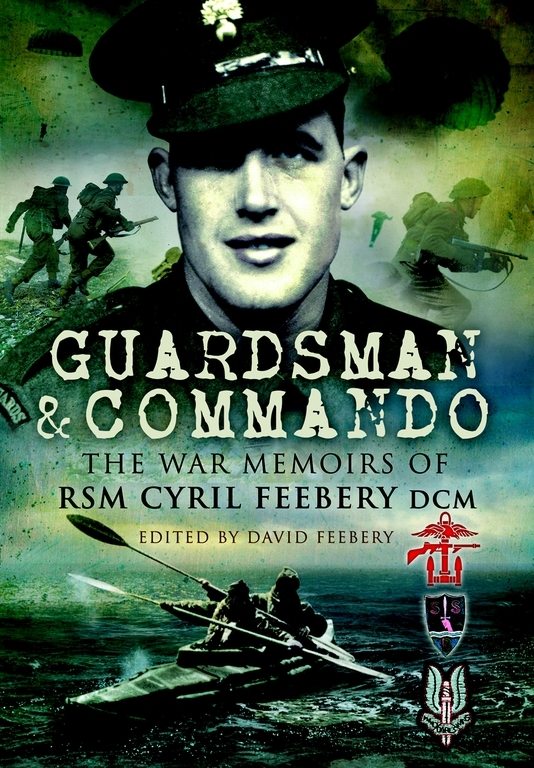Appendix A
Statement made in support of the award of the Distinguished Conduct Medal
by Major T B Langton, MC, 1st SAS Regiment
RE: 2615284 SSM FEEBERY, CYRIL
I have known SSM Feebery since 1941 when he was a Corporal in B Battalion, Layforce.
In September 1941 he and I joined the Special Boat Section in the Middle East, and two months later we took part together in the raid led by the late Lt Col Keyes, VC (Nov 18th 41). Our task was to guide the force ashore and later to try to get them off again. Both these operations were rendered extremely hazardous by the very heavy seas running. Both times Cpl. Feebery showed exceptional courage and coolness, and spent a long time in the water retrieving boats, etc, which got washed off the submarine, and saving the men who went overboard. He and I went ashore to try to get the party off, and were capsized in the surf twice. Our boat was damaged and I lost my paddle altogether. Cpl. Feebery, when I decided to try to return to the ship, paddled us both back through the heavy surf. I have no hesitation in saying that his strength, presence of mind and courage on this occasion saved us from a nasty situation.
In the next few months Special Boat Section personnel were sent out on submarine patrols from Alexandria to be put ashore at the Commanders discretion, if opportunity arose. Feebery made eight trips on submarines which included the patrol of HMS Torbay for which Lt/Commander Myers, DSO, RN, was awarded the VC. All the submarines crew received decorations on this occasion. Reports of submarine commanders on Feeberys conduct and bearing on these patrols were all excellent.
Early in June 1942 Feebery (then Sergeant) was one of a small party under Major Kealy who landed on Crete. Though no positive results were obtained, Major Kealys report which I read and his story which he told me personally, reflected the greatest credit on Sgt. Feebery. Once again his courage and coolness in a difficult situation was excellent.
In August 1942 Sgt Feebery took part in the raid on Benghazi led by Lt Col David Stirling, and again received excellent reports.
When the Special Boat Section was reformed in January 1943 under Major the Earl Jellicoe, DSO, MC, Feebery was made Sergeant Major of the unit, and I have no hesitation in saying that his enthusiasm and drive played a large share in the success of the unit.
Appendix B
Statement made in support of the award of the Distinguished Conduct Medal
by Major J Verney, MC, 1st SAS Regiment
RE: 2615284 SSM FEEBERY, CYRIL
On the night of 29 June 1943, SSM Feebery was put ashore on the west coast of Sardinia from a submarine. There were two parties of five each, commanded by Capt. Thompson 2nd SAS Regiment, and Lt Duggin attached to 2nd SAS Regt, with the rest of L Detachment, Special Boat Squadron, for the operation. SSM Feebery was 2nd i/c to Lt Duggins party.
The two parties landed together at night on the coast within a short distance of an Italian port. They had not been seen, but found themselves at the foot of a high and very steep cliff, with only two hours of darkness left. Five out of the ten including Lt Duggin were in a weak state, thought at first to be the effects of the submarine trip, but which turned out to be malaria. Both officers told me afterwards that without SSM Feeberys great strength and courage they would not have climbed the cliff. He scaled it first with a rope, a hazardous task in the dark, and then made several trips up and down hauling the others and their packs to the top. They were all safely up before dawn and remained concealed the next day. The two parties spilt up then to march to their respective airfield targets.
After six days Lt Duggin and two others were too exhausted with malaria to continue. Owing to the rough going and the delay caused by their weakness, there was no hope of reaching the airfield in time. Lt Duggin told SSM Feebery and the other remaining man, Pte. Noriega, to carry on to the RV on the east coast, laying charges on a railway line which had been given to them as a secondary target if the airfield failed, en route. SSM Feebery and Noriega found the line and laid the charges, and then made for the east coast RV across country.
Unfortunately the RV had already been compromised and rounded up. SSM Feebery and Noriega reached it on 18 July after a tremendous march through enemy country over very rough and difficult going, to find Italian troops there on the lookout. I spoke later to the Italian officer who captured him, having been sent to the RV for that purpose. He knew rubber dinghies had been found on the west coast where Feebery landed, but he did not believe it possible for anyone to walk across the island in the time, and insisted that Feebery must have been dropped by parachute.
I saw Feebery a month later at Maddelena, where we were both waiting to be shipped to Italy. 25 O/Rs from the Special Boat Squadron were with him, and although they were ill from malaria and under-feeding, Feebery had them admirably under control and was keeping them both as smart and as cheerful as could have been expected. Their morale, thanks to his splendid leadership, was quite amazing, and it was amusing to note the respect the Italian guards treated them with, evidently terrified of some sudden coup de main by Feebery.
I was not surprised to hear that when Italy collapsed, Feebery led all his men out of their POW camp in one party and then split them up into smaller parties to make for British lines. Many have now returned safely, including Feebery himself.
Chapter One
The Beginning
I enlisted in the Grenadier Guards on 20 May 1937, a few weeks after my eighteenth birthday, because I fell out with my brother.
We lived in the top floor flat of a Working Mens club in Enmore Road, South Norwood, London, where our Dad was steward. He had been a professional footballer, captain of Crystal Palace for five years until he was forced to retire through injury. As a keen sportsman himself he had always encouraged us, and we both enjoyed cycling, running and swimming. Our favourite sport was boxing. Bert was five years older than me and he joined Croydon boxing club when he was thirteen. He used to practise on me at home so I joined the club as soon as they would let me, mostly to get my own back. Bert was a qualified carpenter, but at the time of our bust-up he was boxing professionally at middleweight and doing very well. We trained and sparred together and although I was boxing at heavyweight by the age of seventeen we were a good match for each other.
Dad put up the money for Bert to buy a car, a Standard Eight, which he was paying back week by week. I was working for a furniture dealer at the time, driving his lorry even though I was so young (the rules about driving were different in those days) and I considered myself every bit as good a driver as Bert. Knowing what we were like, Dad sat us down and spelled out the conditions, one of which was that I could use the car, by arrangement with Bert, provided I paid for the petrol. That seemed fair and we shook on it.
It came to blows, as it was bound to do really, when I wanted to take a girl to the pictures in maximum style. I am certain even now that this had all been arranged, but when the time came Bert wouldnt let me use the car. It was very much his baby, and the keys stayed in his pocket. The fight started in the kitchen of the flat and ended on the doorstep three floors down, leaving a trail of wreckage all the way. No gloves this time, no sparring. We both meant it. Mum and Dad and some of the club members pulled us apart and tried to sort it out but by then I had had enough. There were bitter words in the street and I stormed off, caught the next train to central London and slept rough for a couple of nights. A typical only just eighteen year-old, I wandered around feeling very hard done by, not knowing what to do next but far too obstinate to just go home and face the music.


